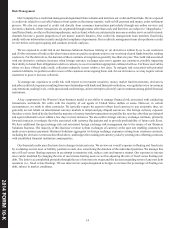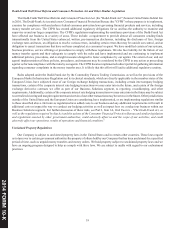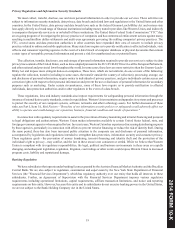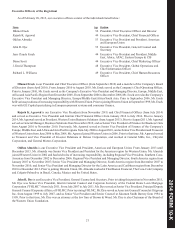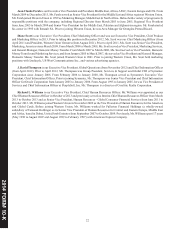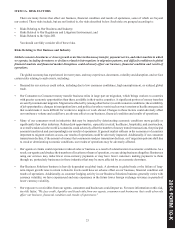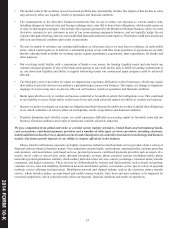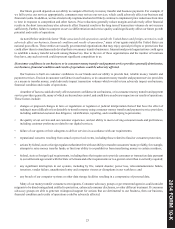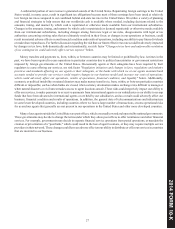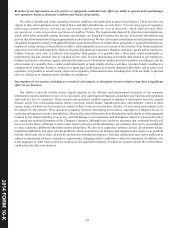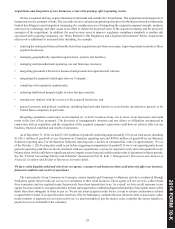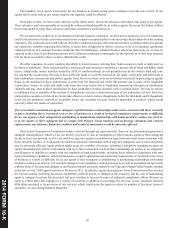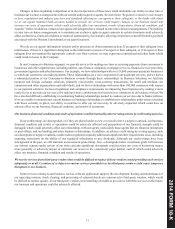Western Union 2014 Annual Report Download - page 162
Download and view the complete annual report
Please find page 162 of the 2014 Western Union annual report below. You can navigate through the pages in the report by either clicking on the pages listed below, or by using the keyword search tool below to find specific information within the annual report.
2014 FORM 10-K
24
• The market value of the securities in our investment portfolio may substantially decline. The impact of that decline in value
may adversely affect our liquidity, results of operations and financial condition.
• The counterparties to the derivative financial instruments that we use to reduce our exposure to various market risks,
including changes in interest rates and foreign exchange rates, may fail to honor their obligations, which could expose us
to risks we had sought to mitigate. This includes the exposure generated by the Business Solutions business, where we write
derivative contracts to our customers as part of our cross-currency payments business, and we typically hedge the net
exposure through offsetting contracts with established financial institution counterparties. That failure could have an adverse
effect on our financial condition and results of operations.
• We may be unable to refinance our existing indebtedness as it becomes due or we may have to refinance on unfavorable
terms, which could require us to dedicate a substantial portion of our cash flow from operations to payments on our debt,
thereby reducing funds available for working capital, capital expenditures, acquisitions, share repurchases, dividends, and
other purposes.
• Our revolving credit facility with a consortium of banks is one source for funding liquidity needs and also backs our
commercial paper program. If any of the banks participating in our credit facility fails to fulfill its lending commitment to
us, our short-term liquidity and ability to support borrowings under our commercial paper program could be adversely
affected.
• The third-party service providers on whom we depend may experience difficulties in their businesses, which may impair
their ability to provide services to us and have a potential impact on our own business. The impact of a change or temporary
stoppage of services may have an adverse effect on our business, results of operations and financial condition.
• Banks upon which we rely to conduct our business could fail or be unable to satisfy their obligations to us. This could lead
to our inability to access funds and/or credit losses for us and could adversely impact our ability to conduct our business.
• Insurers we utilize to mitigate our exposures to litigation and other risks may be unable to or refuse to satisfy their obligations
to us, which could have an adverse effect on our liquidity, results of operations and financial condition.
• If market disruption and volatility occurs, we could experience difficulty in accessing capital on favorable terms and our
business, financial condition and results of operations could be adversely impacted.
We face competition from global and niche or corridor money transfer providers, United States and international banks,
card associations, card-based payments providers and a number of other types of service providers, including electronic,
mobile and Internet-based services, digital currencies and related protocols, and other innovations in technology and business
models. Our future growth depends on our ability to compete effectively in the industry.
Money transfer and business payments are highly competitive industries which include service providers from a variety of
financial and non-financial business groups. Our competitors include banks, credit unions, automated teller machine providers
and operators, card associations, web-based services, payment processors, card-based payments providers such as issuers of e-
money, travel cards or stored-value cards, informal remittance systems, phone payment systems (including mobile phone
networks), postal organizations, retailers, check cashers, mail and courier services, currency exchanges, consumer money transfer
companies, and digital currencies. These services are differentiated by features and functionalities such as brand recognition,
customer service, trust and reliability, distribution network and channel options, convenience, price, speed, variety of payment
methods, service offerings and innovation. Distribution network and channel options, such as the electronic money transfer
service, which includes online, account based and mobile money transfer, have been and may continue to be impacted by
increased competition, which could adversely affect our business, financial condition and results of operations.


